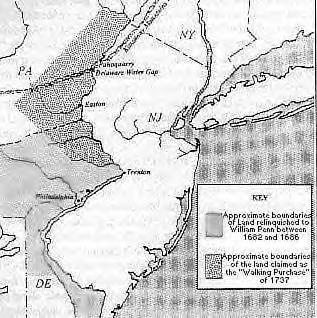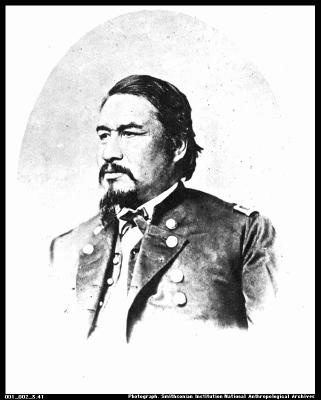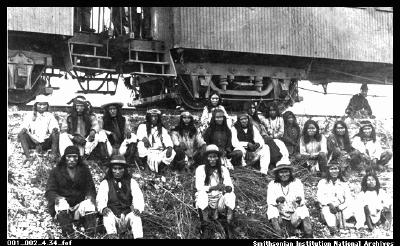|
|
Canku Ota |
|
|
(Many Paths) |
||
|
An Online Newsletter Celebrating Native America |
||
|
August 25, 2001 - Issue 43 |
||
|
|
||
|
This Date In |
||
|
North American Indian History |
||
|
from On This Date in North American Indian History at http://americanindian.net |
||
| Aug 25, 1737: | A agreement will be signed today by Thomas Penn and MUNSEE Chiefs Manawkyhickon and Nutimus. The agreement will call for Indian lands to be sold along the Delaware river for the distance that a man could walk in a day and a half. This would be called the "Walking Purchase" and would be performed on September 19, 1737. |
|
|
|
|
|
|
| Aug 26. 1876: | General Crook,and his soldiers, leave General Alfred "One Star" Terry. They will go east |
|
|
|
| Aug 27, 1735: | According to some sources, a peace agreement is reached today between representatives of the British in Massachusetts Colony and the "IROQUOIS of Canada." |
|
|
|
| Aug 28, 1836: | John Campbell, United States Commissioner to the CREEKs, signs a contract with Opothleyaholo, and other "friendly" CREEK leaders today. Campbell realizes the CREEKs need money to move to Indian Territory, and to satisfy their debts in Alabama. The Government will give the CREEKs their $31,900 annuity in advance, so they can pay their debts. The CREEKs agree to provide 600 to 1000 warriors to fight the SEMINOLEs. The CREEKs will serve until the SEMINOLEs surrender totally. |
|
|
|
| Aug. 29, 1759: | Today, MOHEGAN Samson Occom will be ordained as a minister by the Suffolk Presbytery of Long Island, New York. While living with Rev.Eleazar Wheelock, he had studied numerous foreign languages, including Hebrew and Greek. Eventually, he would be sent to England to help raise funds for Wheelock's Indian "Charity" School. Occom would be the first Indian Minister to deliver a sermon in England. His fund-raising efforts would be so outstanding that Wheelock's School could afford to move to New Hampshire, and would eventually become Dartmouth College. |
|
|
|
| Aug. 30, 1858: | Oshkosh was a NEMOMINEE Chief. During his lifetime he fought in many conflicts including for the British in the war of 1812, and for the Americans in Black Hawk's War. He was appointed as the Chief of the MENOMINEEs by Lewis Cass during the negotiations of the Treaty of Butte des Morts. After surviving battles with the Europeans and other Indians, Oshkosh met his end due to a more insidious enemy, alcohol. |
|
|
|
| Aug. 31, 1905: | Today, Ely Samuel Parker (Donehogawa) dies in New York City. During his lifetime he will be a SENECA Chief, an engineer, a lawyer, the New York City Building Superintendent, a Brigadier General in the Civil War where he will write the surrender papers signed at Appomattox, and the first Indian Commissioner of Indian Affairs. Born in 1828, he will be buried in Buffalo, New York. |
|
|
|
|
|
|
| Sept. 1, 1788: | Even after the Treaty of Hopewell, whites will continue to settle on CHEROKEE lands along the Holston and French Broad Rivers. Today Congress will issue a proclamation prohibiting whites from settling on CHEROKEE lands. |
|
|
|
| Sept. 2, 1732: | Today, the first treaty between the IROQUOIS Confederation, and the Pennsylvania Provincial Council will be signed in Philadelphia. The parties will agree to peaceful relations between them. The IROQUOIS also promised to try to persuade the SHAWNEEs to leave Allegheny Valley. The Principal Indian Chief present will be Shikellamy of the ONONDAGA. |
|
|
|
| Sept. 3, 1719: | Today, Frenchman Bernard de la Harpe, discovers an Indian village on the Arkansas River, near Muskogee. La Harpe had traveled up the Red river, then went overland across Oklahoma. He will describe the land as fertile, and the people (probably a CADDOAN tribe) as friendly, and hard working. La Harpe will claim the land for France. |
|
|
|
| Sept. 4, 1886: | Geronimo surrenders to General Nelson Miles at Skelton Canyon south of Apache Pass. |
|
|
|
|
In an effort to end the conflict with the Indians, the U.S. government began taking many Native Americans as prisoners in 1875 and sending them to the seventeenth-century dungeons at Fort Marion in St. Augustine, Florida. In 1886, Geronimo and his band o f Apaches finally agreed to end hostilities and move to a reservation. However, they, too, were sent to Fort Marion, via San Antonio, where the picture above was taken. |
|
| Sept. 5, 1862: | Today, Little Crow hears news of Big Eagle and Mankato's battle with Col.Henry "Long Trader" Sibley's troops at Birch Coulee. They have managed to bottle up the troops for an entire day, only cannon being brought up will end the fighting on the second day. |
|
|
|
| Sept. 6, 1973: | The Oklahoma Human Rights Commission requests state schools drop rules requiring Indian students to cut their long hair. They felt the rules would "promote racial friction and community divisiveness." |
|
|
|
| Sept. 7, 1968: | The Indian Council Fire awards this year's Indian Achievement Award to Rev.Dr.Roe B.Lewis, of Phoenix, Arizona. Lewis, a PIMA-PAPAGO, is cited for his efforts in educational counseling for Indians. |
|
|
|
|
For Information on This Date in Canada visit our friends at: |
|
Canadian
Aboriginal News |
|
|
||
|
|
||
| Canku Ota is a free Newsletter celebrating Native America, its traditions and accomplishments . We do not provide subscriber or visitor names to anyone. Some articles presented in Canku Ota may contain copyright material. We have received appropriate permissions for republishing any articles. Material appearing here is distributed without profit or monetary gain to those who have expressed an interest. This is in accordance with Title 17 U.S.C. section 107. | ||
|
Canku Ota is a copyright © 2000, 2001 of Vicki Lockard and Paul Barry. |
||
|
|
|
|
|
The "Canku Ota - A Newsletter Celebrating Native America" web site and its design is the |
||
|
Copyright © 1999, 2000, 2001 of Paul C. Barry. |
||
|
All Rights Reserved. |
||



